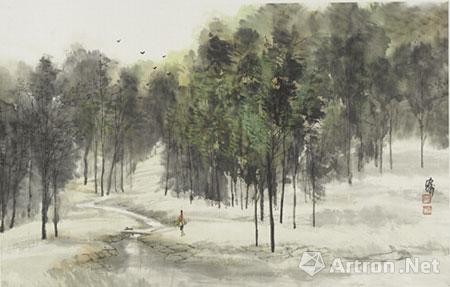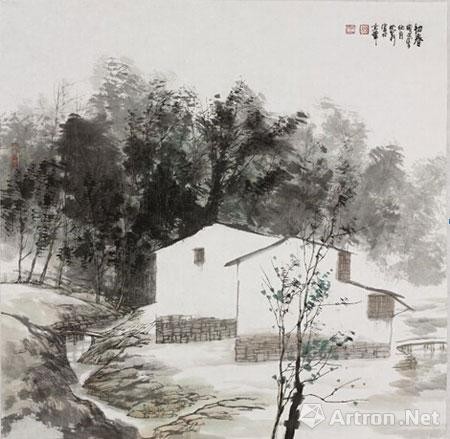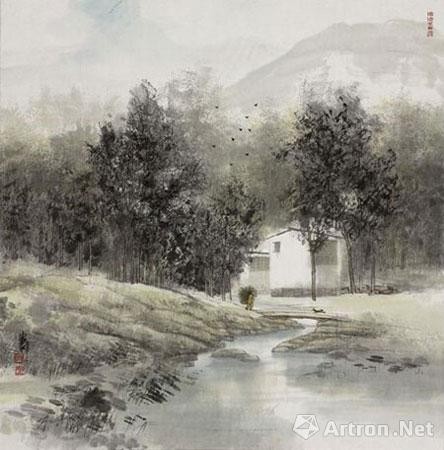The bony face, calm look and long beard of Yang Jiayong leave us an expression that he seems to come from the Middle Ages. He looks like a hermit in the metropolis, who walks silently in his ideal nation.
Yang Jiayong graduated from the Academy of Arts & Design, Tsinghua University (former China Central Academy of Arts and Design) in the early years, and he attended the Art Exhibition "The Advancing Chinese Youth" in 1985 with his oil painting works created during his university life, which once helped many unknown painters shoot to fame, but Yang Jiayong did not step into the queue of modern oil painter. To the contrary, he turned to academism and learned traditional Chinese painting in Zhang Ting Studio. After graduation, he went back to the South of the Yangtze River and started his exploration and research of traditional Chinese painting for nearly 20 years. He did not attend any art exhibition of traditional Chinese painting until 2002 with his artwork, "Watery Village". 17 years have passed since his first attendance of oil painting exhibition. We can feel his wandering and hardship from his past experiences. However, all the difficulties and set-backs brought rich and generous returns to him since his works are finally presented in front of us with fresh individual style.

When you look at the ink paintings of Yang Jiayong, it makes us feel that we are entering a pure shrine. Under his brush, the watery village in the South of the Yangtze River has magically changed into a sedative realm with dense intangible mist, just like a poetic nation. It represents the cultural identity and spiritual character of a typical watery village in the South of the Yangtze River, as well as the ideal state and aesthetic pursuit of the painter himself. In the landscape painting of Yang Jiayong, you will never see the fickleness and uproar of the mortal world but only the eternal clearness of the invisible serenity. His paintings do not show complicated composition and paining techniques with mystification, but resemble whispering ancient music, which gives people a strong feeling that could linger around your mind for a long time. His concealment of technique is never a denial of technique but refers to his implication of technique in the smooth picture, so as to realize an extraordinary effect through hiding ink marks.

From the aspect of technique, Yang Jiayong's artworks show two characteristics. Firstly, the painter is good at integrating the shade of light and ink color with shading effect, to create a deeply serene space through the shade and dry-wet situation of Chinese ink. The clear light and shade integrates perfectly with the well-arranged ink, which creates a magic effect full of fantasy. "Small Boat on the Calm Lake"(2009) demonstrates a typical summer view in the South of the Yangtze River, in which the thick shade of trees and cottages with white walls and black-tied roofs set each other off nearby the water. In this artwork, the application of ink is quite free since the painter shades large blocks of ink on the painting and then sets off the smooth and green charm in the South of the Yangtze River after summer rain by breaking Chinese ink through color or breaking color through Chinese ink. Under the mutual reflection of traditional ink, lights and shades are wandering in the painting; therefore the space is growing deeper and wider. To the contrary, "Trees after the Prolonged Raining" (2006) represents the acme of using the overlapping and shadowing of Chinese ink and color since the natural vignette blur of Chinese ink and the cracking and rubbing of ink sticks and ink dots constitute a perfect artwork full of imagery. In "Path" (2008), the painter fully adopts the method of mutual break between ink and wash drawing, in which the overlapping dying of ink turns into green and thick forest, and the close brook is becoming transparent and clear under the cracking and dying of light ink. The cracking and dying of such a kind of Chinese ink becomes thick in Yang Jiayong's artwork, "Limpidity" (2009), in which, the Chinese ink looks like black paint under overlapping dying and the light yellow color becomes limpid under the contrast of Chinese ink. It givers us an illusion that the light is shining through the back of forest and the light sensation and ink color are blending with each other surprisingly. "Colorful Countryside" (2007) is an artwork with strong coloration, in which, Yang Jiayong used a lot of green color and yellow color, to half-tone the golden leaves and dark green leaves. Colors are embellishing in moist ink, which creates a penetrating effect of the blending of color and ink and set off the warmth of beautiful autumn by contrast. "Red Leaves and Green Mountains" (2005) takes advantage of the characteristics of mutual penetration of ink and color, which connects a mass of various yellow colors such as medium-yellow, light-yellow, saffron-yellow and the moist ink colors with different shade on one hand, and diffuses color and ink naturally with blending on the other hand. Such a kind of blending between ink and color which aims to create the atmosphere of picture through mutual penetration can be seen in the following artworks: "Pool" (2007), "Playing by the Sinuous Crystal Stream" (2007) etc. The skillful application of ink and color endow the artworks of Yang Jiayong with an elegant and exquisite sense of intangibility through the blending of ink and color, which almost constitutes the landmark style of Yang Jiayong's painting works.


Secondly, as to the aspect of using brush, Yang Jiayong integrates realistic painting skill into traditional language of ink and color, which fully shows his flexibility in using painting brush. The painter wields the brush according to the shape and tendency of physical phenomena, which not only attends to the objective shape of physical phenomena but also cares for the fluency and charm of painting movement. In "Breeze" (2008), the white wall and black tie is purified into ink block, lines and blankness. From the perspective of modeling, the old house and small bridge on the picture are quite realistic but the language of ink and color on it is quite traditional. The painter fully utilizes the peculiar interest of ink and color, to control the smoothness of line and thickness of plane, the depth of color and flourish of ink under his flexible use of painting brush, which makes it complementary and sparkling. In "Traveling in the South of the Yangtze River" (2009), ink changes into abstract elements of line and plane. In the black and white structure of toing and froing, the rhythm sensation of contrast between black and white as well as the appropriate shade of color which is typical to the South of the Yangtze River, is gradually appearing. Yang Jiayong also adopts another kind of meticulous wielding method, for example, in his description of tree and grass in "Return" (2007), he uses the method of cracking, rubbing and dotting to build the effect of compactness, moisture and intricacy. "Playing by the Sinuous Crystal Stream" (2007) uses the method of repeatedly cracking and rubbing to manifest the thickness of tree leaves and prosperity of grassland by combining complicated and compact wielding method. Such a kind of wielding method can be seen in "Trees after the Prolonged Raining" (2006), "Quite Mountains"(2008). The flexibility and variety of wielding bring many novel and fresh effects to the artworks of Yang Jiayong. The mutual blending of wielding method and the method of using ink and water finally bring us the perfect combination of picture and mindset.

Through his manipulation of brush and ink as well as the exquisite composition of picture, Yang Jiayong enhances the state of his artworks to a new altitude, which can be summarized into "Emptiness" and "Serenity". First, emptiness. It refers to a ladder that could guide you to the remoteness. In traditional Chinese philosophy, people can only get to the remote state through emptiness; therefore Lao Tzu once said that "Remoteness means return". Life forms in painting can continue endlessly in the reciprocating circle of "Remoteness leads to return". It requires that the painter or artist have a vacant mind to wash secular feelings since only in this way can he or she reach a state of emptiness and remoteness. The emptiness of such a mindset can be manifested in the application of blankness in the artworks of painter. In the paintings of Yang Jiayong, the use of blankness is quite common, for example, the repeated appearance of blankness in "Traveling In The South Of The Yangtze River", the white walls set off by greenness in "Early Spring", as well as the remote cloud in "Reclusion" are all equipped with the clearness and agility of emptiness. Second, serenity. Zhuang Zi connects serenity with spirit, which can be reflected in his verse: if water is unceasingly flowing, it can not be used as a mirror to reflect people; therefore standards have to be fixed and unified to enlighten the world. Only through many years of practice can the painter precipitate his passionate emotion into serene image, just like Zhen Xie said in his verse: sometimes it is light and sometimes it is thick, which signifies that all is empty in regard of mind. Only in this way can the image presented on the painting reach the state that deep pool could reflect all spring sceneries and the ancient mirror could reflect the true spirit of mortal people (Si Tukong). Yang Jiayong's experience in the South of the Yangtze River gave birth to his quite and affectionate character. All the past sorrows and joys were smoothed by the beauty and charm of the South of the Yangtze River. The inner passion finally precipitated into the calm and serene world. The image of "Serenity" is omnipresent in the painting works of Yang Jiayong such as "Calm Boat" (2008), “Reflected Image Of The Small Bridge And Cottages” (2008), “Lonely Boat Under The Moon” (2008), "Small Boat On The Calm Lake" (2009), "Trees After The Prolonged Raining" (2006), "Leisure" (2009). In other words, the landscape of Yang Jiayong is a serene world, in which, his contemplation gets perfect expression in his elaborate structure of imagology.
The peculiar charm of plain elegance expressed in the artworks of Yang Jiayong originates from his quite and clear mindset on one hand, and his stand-fast of traditional brush and ink as well as his smart renovation on the other hand. As to Yang Jiayong, brush and ink are not only the main language of ink painting but also the cultural symbol of peculiar connotation that should be insisted. In the artworks of Yang Jiayong, we can feel a vitality of life and the artistic leap brought by contemplation. It is a kind of sublimation of spirit after tasting the savor with clear and pure moods. Under the contemplation of aesthetics, we can feel the serenity and beauty that could wash and clean our mind.
Zhang Xiaoling,Vice President of China National Academy of Painting ,professor,doctoral supervisor。
[ Translator: Wu Xiaolei ]
Copyright Reserved 2000-2024 雅昌艺术网 版权所有
增值电信业务经营许可证(粤)B2-20030053广播电视制作经营许可证(粤)字第717号企业法人营业执照
 京公网安备 11011302000792号粤ICP备17056390号-4信息网络传播视听节目许可证1909402号互联网域名注册证书中国互联网举报中心
京公网安备 11011302000792号粤ICP备17056390号-4信息网络传播视听节目许可证1909402号互联网域名注册证书中国互联网举报中心
网络文化经营许可证粤网文[2018]3670-1221号网络出版服务许可证(总)网出证(粤)字第021号出版物经营许可证可信网站验证服务证书2012040503023850号